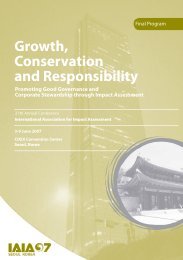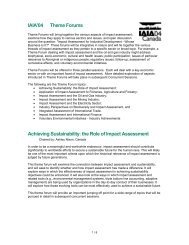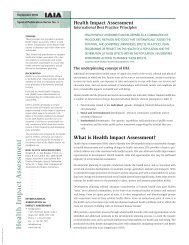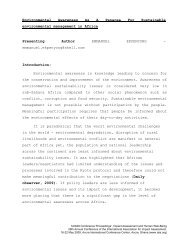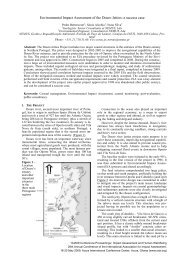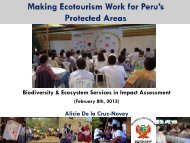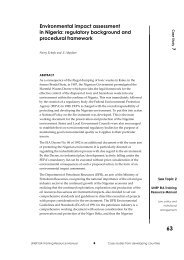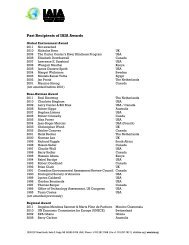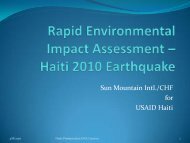Power, poverty and sustainability - International Association for ...
Power, poverty and sustainability - International Association for ...
Power, poverty and sustainability - International Association for ...
Create successful ePaper yourself
Turn your PDF publications into a flip-book with our unique Google optimized e-Paper software.
• IAIA06 Abstracts Volume •<br />
CS 15.4 ROUNDTABLE EMPOWERING<br />
PEOPLE TO PARTICIPATE IN SIAS<br />
CS 16.1 TRANSPORT SEA<br />
A Practical Example of Tiering–Linking SEA of<br />
Different Levels of Transport <strong>and</strong> L<strong>and</strong> Use Planning<br />
in Wales<br />
Fundingsl<strong>and</strong> Tetlow, Monica; Centre <strong>for</strong> Sustainability, TRL,<br />
Crowthorne House, Nine Mile Ride, Wokingham, Berkshire<br />
RG40 3GA Engl<strong>and</strong>. +44 (0)1344 770146. mtetlow@trl.co.uk<br />
Gardner, Robert; Centre <strong>for</strong> Sustainability, TRL, Crowthorne<br />
House, Nine Mile Ride, Wokingham, Berkshire RG40 3GA<br />
Engl<strong>and</strong>. +44 (0)1344 770575. rgardner@trl.co.uk<br />
The Welsh Assembly Government is currently undertaking a<br />
Strategic Environmental Assessment (SEA) <strong>for</strong> the emerging<br />
Wales Transport Strategy. The national transport strategy is<br />
due to be finalised in 2006, <strong>and</strong> will be implemented through<br />
four Regional Transport Plans. These are due in 2007 <strong>and</strong> will<br />
each require a separate SEA. The transport strategy is one of<br />
the national actions to arise from the Wales Spatial Plan,<br />
which was adopted in November 2004. This plan is currently<br />
under revision <strong>and</strong> will also be subject to an SEA, as will<br />
some of its individual components.<br />
The nature <strong>and</strong> timing of these SEA activities presents a<br />
unique opportunity to develop a coherent approach that<br />
enables SEA to effectively support transport <strong>and</strong> l<strong>and</strong> use<br />
planning activities in Wales. A coordinated approach to SEA is<br />
there<strong>for</strong>e being taken to avoid duplication of ef<strong>for</strong>t in activities<br />
such as setting objectives <strong>and</strong> indicators, baseline data<br />
collation <strong>and</strong> monitoring. This paper seeks to apply some of<br />
the tiering concepts considered by Jos Arts <strong>and</strong> Paul<br />
Tomlinson at IAIA Prague. It outlines a common framework<br />
that is being developed <strong>for</strong> the SEA activities in Wales, <strong>and</strong><br />
provides a practical example of vertical <strong>and</strong> horizontal tiering<br />
across different planning sectors.<br />
Strategic Environmental Assessment <strong>and</strong> L<strong>and</strong>scape<br />
Fragmentation<br />
Andìl, Petr; EVERNIA Ltd., tø. 1. máje 97, Liberec, 460 01<br />
Czech Republic. +420 485 228 272. <strong>and</strong>el@evernia.cz<br />
The paper deals with the role of strategic environmental<br />
assessment in the regulation of l<strong>and</strong>scape fragmentation in the<br />
Czech Republic. The basic problem is the fragmentation<br />
caused by transpot that includes two basic parts: (a)<br />
maintaining non-fragmented areas large enough to ensure<br />
partial populations, (b) decreasing the barrier effect as a basis<br />
<strong>for</strong> migration between the partial populations. The<br />
methodology <strong>for</strong> assessment the both aspects is described.<br />
The principle is in defining unfragmented areas with traffic<br />
<strong>and</strong> establishing their quality (quantifying suitable biotops<br />
<strong>and</strong> quantifying risk of further fragmentation). This<br />
unfragmented areas are compared with the prepared<br />
motorways <strong>and</strong> roads. The possibilities of SEA process are<br />
demonstrated in two practical examples: (i) SEA <strong>for</strong><br />
“Transport policy of the Czech Republic <strong>for</strong> 2006 – 2013” <strong>and</strong><br />
(ii) SEA <strong>for</strong> “L<strong>and</strong>-use plan of region Karlovy Vary (CZ).” In<br />
both cases the results were evaluated as successful <strong>and</strong><br />
Ministry of Environment recommended this methodology <strong>for</strong><br />
futher applications.<br />
Transposition of the European SEA Directive <strong>and</strong><br />
Implications <strong>for</strong> English Local Transport Plans.<br />
Fundingsl<strong>and</strong> Tetlow, Monica; Centre <strong>for</strong> Sustainability,<br />
TRL, Crowthorne House, Nine Mile Ride, Wokingham,<br />
Berkshire RG40 3GA Engl<strong>and</strong>. +44 (0)1344 770146.<br />
mtetlow@trl.co.uk<br />
This paper presents the findings from a study into how<br />
the SEA Directive has been transposed <strong>for</strong> English Local<br />
Transport Plans, focussing on a review of internal <strong>and</strong><br />
external threats to a successful SEA.<br />
The appraisal process that was in place <strong>for</strong> assessing the<br />
environmental implications of Local Transport Plans<br />
prior to the SEA Directive entering into <strong>for</strong>ce had limited<br />
influence on plan preparation. The requirement <strong>for</strong><br />
taking SEA into account there<strong>for</strong>e presents an<br />
unprecedented opportunity <strong>for</strong> strengthening the<br />
influence of transport appraisal in Engl<strong>and</strong>, <strong>and</strong><br />
ultimately <strong>for</strong> improving the environmental outcome of<br />
Local Transport Plans. However, aspects of the<br />
institutional <strong>and</strong> regulatory context within which the<br />
SEA requirements <strong>for</strong> Local Transport Plans are being<br />
implemented represent potential threats to the successful<br />
implementation of this requirement. Some of these<br />
threats are within the control of individual authorities<br />
<strong>and</strong> SEA/ Local Transport Plan practitioners, whereas<br />
others are not.<br />
This paper investigates ways to optimise the<br />
opportunities presented by the requirement to take SEA<br />
into account during plan preparation, whilst minimising<br />
the threats to successful implementation of this<br />
requirement. Using the English transport planning <strong>and</strong><br />
appraisal system as a basis, the paper identifies issues<br />
that may be of relevance to other countries.<br />
Tiering SEA And Project EIA: Lessons From<br />
Highway Planning in São Paulo, Brazil<br />
Sánchez, Luis; Universidade de São Paulo, Av. Prof.<br />
Mello Moraes, 2373, São Paulo, SP 05508-900 Brazil.<br />
+55 11 3091-5186. lsanchez@usp.br<br />
Silva-Sánchez, Solange; Consultant, Rua Judith P.<br />
Esteves, 255/14C, São Paulo, SP 05625-030 Brazil.<br />
solss@usp.br<br />
Constructing highways in dense urban areas is always a<br />
challenge. In São Paulo Metropolitan Region, heavy<br />
truck traffic contributes to clog streets <strong>and</strong> expressways<br />
alike. As part of the traffic neither originates nor heads<br />
to the region, a peripheral highway has been proposed to<br />
reduce traffic problems. This project, called Rodoanel,<br />
encompasses a 6 to 8 lane expressway 175 km long<br />
linking major highways radiating from São Paulo.<br />
The agency in charge, Dersa, filed a first environmental<br />
impact statement, considered as insufficient by the State<br />
Department of Environmental Impact Assessment. Thus,<br />
Dersa commissioned a strategic environmental<br />
assessment of a revamped project, called Rodoanel<br />
Program.<br />
This paper discusses the decision-making implications of<br />
such as change, critically reviews the SEA report <strong>and</strong><br />
elaborates on the shortcomings of a second EIS prepared<br />
after the SEA report <strong>and</strong> based on its major findings <strong>and</strong><br />
recommendations. Authors argue that, far from featuring<br />
a genuine SEA process, Rodoanel SEA was merely<br />
intended to facilitate project approval, <strong>and</strong> failed to<br />
satisfactorily take account of significant strategic issues.<br />
Among these, the highway potential effect of inducing<br />
urban sprawling over water protection zones was the<br />
most critical issue considered in the environmental<br />
decision-making processes.<br />
66


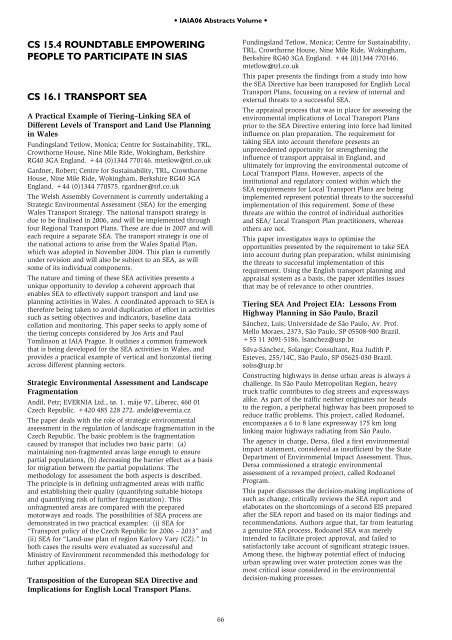

![Session Report [PDF] - International Association for Impact Assessment](https://img.yumpu.com/22416146/1/190x245/session-report-pdf-international-association-for-impact-assessment.jpg?quality=85)
![Session Report [PDF] - International Association for Impact Assessment](https://img.yumpu.com/22416140/1/184x260/session-report-pdf-international-association-for-impact-assessment.jpg?quality=85)
